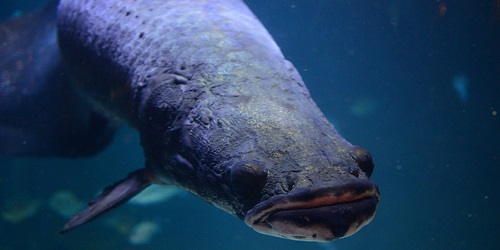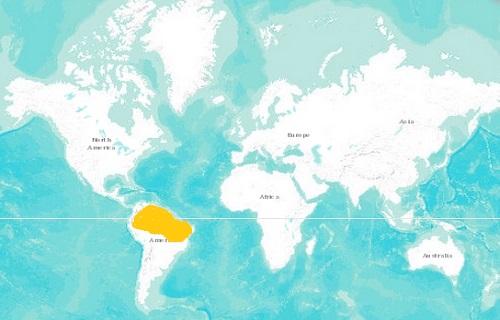0
Taxonomy

Arapaima gigas at the Shanghai Ocean Aquarium.
- Kingdom: Animalia
- Phylum: Chordata
- Class: Actinopterygii
- Order: Osteoglossiformes
- Family: Arapaimidae
- Genus: Arapaima
- Species: Arapaima gigas
0
Name
- Scientific name: Arapaima
- Common name: Pirarucu in Brazil, paiche in Peru.
Physical Features
- The arapaima is the largest freshwater fish.
- They have a large and wide mouth with a toothed tongue which is a characteristic of the osteoglossiformes order.
- It has a streamlined body with green-gray scales which can reach 2.36 in or 6 cm in length. Near the end of its body it has orange or red speckled scales.
- Its dorsal and anal fins are set near the tail.
- The arapaima is unique among other fish in that they breathe air from the surface. They have primitive lungs which allows them to breathe air from the surface and gills that allow them to breathe under water. Their bodies have adapted due to the low oxygen levels in their habitat.
Weight and Length
- An arapaima can weigh up to 441 lbs or 200 kg.
- It can reach lengths of 14.76 feet or 4.5 m long.
- Its size has been reduced in its native habitat by overfishing.
Distribution and Habitat
- The arapaima is native to the Amazon River basin and its tributaries. Its range includes the countries of Peru, Guyana and Brazil.
- It has been introduced to parts of East Asia.
- The arapaima native habitat includes flooded forests during the wet season. Lakes, river channels, swamps, ponds and streams during the dry season.
- Much of the water where it inhabits is oxygen deficient.
Diet
- The arapaima is a carnivore and eats other fish, crustaceans, frogs and birds near the surface of the water.
Behavior
- Arapaimas depend on surface air to breathe so they have to emerge to the surface every 5 to 15 minutes making distinctive gulp noises as they breath.
- They swim in small groups and are diurnal.
- The arapaima does not bite with its jaw but uses its tongue which is covered with teeth against the roof of its mouth.
- The arapaima is unique among fishes in that they breathe air.
Reproduction
- Arapaimas reach reproductive age between 4 to 5 years old when they are on average 5.25 feet or 160cm. Their spawning is regulated by season.
- From the month of February to April the male and female pair builds a nest 19.7 in or 50 cm wide and 5.9 in or 15 cm deep in the sandy bottom of the riverbed when water level is low.
- The female deposits up to 50,000 eggs and the male externally fertilizes them. The male protects the eggs and the female guards the territory against predators.
- Eggs hatch after 4 to 5 days of fertilization between May and August when water level rises. The high water levels bring food necessary for the young to thrive.
- The male protects the young for three months and when water recedes juveniles and adults separate.
Predators
- Its main predators are humans and spectacled caimans (caiman crocodiles).
Life Expectancy
- In captivity life expectancy is from 15 to 20 years.
Threats
- Because they regularly need to swim to the surface to breathe they are target for fishermen.
- Arapaima has been a traditional source of food for natives of the Amazon but because of its commercialization it has been overexploited becoming rare where it was once abundant.
- Its range is declining because of overfishing.
Conservation Status
- The arapaima trade is restricted by CITES II.
- The IUCN Red List of Threatened Species lists this species as “data deficient”.
Interesting facts about the arapaima fish
- Its meat is considered a delicacy.
- The arapaima is among the oldest fresh water fish on earth.
- There are only two species of fish with bonytongues. The arapaima and the African arowana.
- The arapaima lives in the same waters as piranhas and has evolved a piranha proof body. The tough scales are made of highly mineralized collagen which makes it hard. Its corrugated shape makes it flexible so the scales do not break when the piranha bites.
References and further research
Convention on International Trade in Endangered Species of Wild Fauna and Flora – Arapaima Gigas
Smithsonian National Zoological Park – Arapaima Facts
BBC Earth News – The giant Amazon arapaima fish in ‘under threat’

